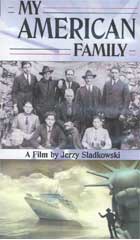
My American Family 2004
Distributed by First Run/Icarus Films, 32 Court St., 21st Floor, Brooklyn, NY 11201; 800-876-1710
Produced by Antonio Russo Merenda
Directed by Jerzy Sladkowski
VHS, color, 70 min.
Jr. High - Adult
Multicultural Studies, European Studies, Sociology
Date Entered: 05/27/2005
Reviewed by Beth A. Kattelman, Columbus Metropolitan Library, Columbus, OHThis delightful documentary explores the strength of that unseen bond that can only be created by sharing family ties. It follows the Merenda family, one of the founding families of Paterno Calebro, a small village in southern Italy. Most members of the Merenda family immigrated to America over a century ago, and throughout the subsequent years the ties between those in America and those who chose to stay in the “old country” have almost become non-existent. In 2002, however, 70-year-old Gaetano Merenda (the filmmaker’s father) and his wife are invited to be the guests of honor at a Merenda family reunion to be held in Kansas. In honor of the occasion, Gaetano acquires a video camera in order to document the village of Paterno and its inhabitants so that he can share these visions of his hometown with his American relatives at the reunion. The trip to the United States also takes on another purpose for the filmmaker, because he uses it to explore the past of one relative whose memory has been almost entirely erased by the family. Francesco ‘Pirune’ Merenda is the black sheep that no one wants to talk about. He was one of the first to immigrate to America, but his ultimate activities and whereabouts remain cloaked in mystery. During the American trip, the filmmaker uncovers some very interesting facts about Pirune and reclaims a place for him in the family tree.
The first two-thirds of My American Family are primarily an “extended home movie” created prior to and while at the reunion. Some segments are filmed by the director, while others are filmed by his father. Because of the hand-held nature of this part of the video, it is very shaky and the quality is extremely uneven. Many of the shots are poorly framed, or they drift off of the subject. Even so, there is a charming quality to the roughness of the video that perfectly suits the subject matter. The final third of the video takes the viewer back to Paterno to show more of the community and its inhabitants. The filming in this section is more professional and less shaky, yet it still maintains the vitality and immediacy of the first parts.
Some of the stranger elements in this documentary are the animated photographs of past generations of the Merenda family that appear between and within some segments. The photos have been animated by cutting and moving certain segments (similar to the technique used in Monty Python.) In this way, the animators can make the eyes wink, or a hand move, etc. This comes off as a bit creepy, however, and I believe the video would have been better off just showing the still photographs without this enhancement. This element does not seriously detract from the overall quality of the video, however. The warmth and vitality of this documentary are infectious. It provides an “up close and personal” glimpse of life in southern Italy and is a wonderful homage to the strength of family ties. It is highly recommended for both academic and public libraries.